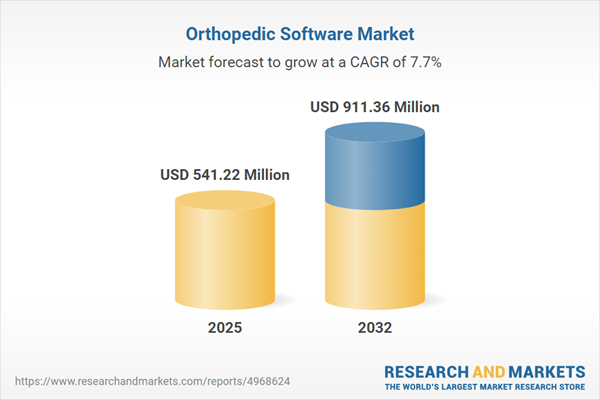Speak directly to the analyst to clarify any post sales queries you may have.
The orthopedic software market is rapidly evolving, powered by advancements in imaging, data analytics, and digital integration. Orthopedic solutions now bring together clinical and operational intelligence, transforming the delivery and management of musculoskeletal care for healthcare leaders seeking growth and efficiency.
Market Snapshot: Orthopedic Software Market Growth and Outlook
The Orthopedic Software Market grew from USD 503.08 million in 2024 to USD 541.22 million in 2025. It is expected to continue growing at a CAGR of 7.70%, reaching USD 911.36 million by 2032.
Scope & Segmentation of the Orthopedic Software Market
This report delivers a comprehensive analysis of market sub-segments, technologies, deployment modes, applications, and regions to provide strategic clarity for decision-makers.
- End Users: Hospitals, Ambulatory Surgical Centers, Clinics
- Deployment Modes: Cloud-Based, On-Premise
- Applications:
- Analytics and Reporting (Business Intelligence, Predictive Analytics)
- Electronic Health Record (Clinical Documentation, Order Management)
- Image Management (DICOM Viewer, PACS)
- Patient Engagement (Home Monitoring, Telehealth)
- Surgical Workflow (Preoperative Planning, Intraoperative Guidance, Postoperative Analysis)
- Platforms: Desktop Platform, Mobile Platform, Web Platform
- Technologies:
- 3D Imaging (CT Based, MRI Based)
- AI-Powered (Deep Learning, Machine Learning)
- Augmented Reality (Surgical Navigation, Training)
- Virtual Reality (Education, Rehabilitation)
- Regions Covered: Americas (including North America and Latin America), Europe, Middle East & Africa, Asia-Pacific (expansive country-level breakdowns across all geographies)
- Key Companies Profiled: Stryker Corporation, Zimmer Biomet Holdings, Johnson & Johnson Services, GE HealthCare Technologies, Siemens Healthineers, Koninklijke Philips, Brainlab, Materialise, 3D Systems, Medtronic
Key Takeaways: Strategic Insights for Orthopedic Software Stakeholders
- Healthcare systems are prioritizing integrated software platforms that enhance both clinical precision and administrative efficiency.
- Adoption of augmented and virtual reality modules is accelerating in intraoperative navigation, surgeon training, and patient rehabilitation across diverse settings.
- Predictive analytics and advanced reporting tools are empowering stakeholders to tailor protocols and proactively manage patient outcomes.
- Vendors are differentiating through secure, scalable, and user-friendly architectures, leveraging strategic partnerships with imaging, academic, and cloud technology providers.
- The convergence of mobile, desktop, and web platforms delivers actionable data and insights to clinicians, administrators, and patients, regardless of location.
Tariff Impact: Shaping Sourcing and Deployment Strategies in Orthopedic Software
New United States import tariffs implemented in 2025 raised operational costs on software-related hardware, driving market participants to re-evaluate supply chains and procurement. Many vendors responded by strengthening regional manufacturing partnerships and shifting toward cloud-native solutions, which lessen reliance on imported hardware infrastructure. Healthcare organizations increasingly use subscription models and bandwidth-efficient deployments to address new fiscal pressures. These trends underline the importance of flexible procurement, robust legal-compliance alignment, and cost mitigation strategies for both providers and buyers.
Methodology & Data Sources
The market insights are derived from rigorous secondary research of peer-reviewed journals, industry white papers, regulatory filings, and public disclosures. This is augmented by primary interviews with orthopedic surgeons, IT directors, product managers, and health executives. Quantitative findings are validated using triangulation, and qualitative results are reviewed by healthcare technology experts to ensure reliability and accuracy.
Why This Report Matters
- Gain a clear understanding of fast-changing orthopedic software ecosystems, including the impact of regulations and tariffs.
- Identify high-opportunity market segments, emerging technologies, and strategic partnerships shaping future growth.
- Support informed investment and procurement strategies with detailed segmentation and regional analysis.
Conclusion
The orthopedic software market is evolving through technology integration, resilient supply chains, and patient-focused digital advancements. Senior decision-makers are equipped to navigate complexity, seize innovation, and drive superior clinical and operational outcomes with the insights from this report.
Additional Product Information:
- Purchase of this report includes 1 year online access with quarterly updates.
- This report can be updated on request. Please contact our Customer Experience team using the Ask a Question widget on our website.
Table of Contents
3. Executive Summary
4. Market Overview
7. Cumulative Impact of Artificial Intelligence 2025
Companies Mentioned
The companies profiled in this Orthopedic Software market report include:- Stryker Corporation
- Zimmer Biomet Holdings, Inc.
- Johnson & Johnson Services, Inc.
- GE HealthCare Technologies Inc.
- Siemens Healthineers AG
- Koninklijke Philips N.V.
- Brainlab AG
- Materialise NV
- 3D Systems, Inc.
- Medtronic plc
Table Information
| Report Attribute | Details |
|---|---|
| No. of Pages | 185 |
| Published | October 2025 |
| Forecast Period | 2025 - 2032 |
| Estimated Market Value ( USD | $ 541.22 Million |
| Forecasted Market Value ( USD | $ 911.36 Million |
| Compound Annual Growth Rate | 7.7% |
| Regions Covered | Global |
| No. of Companies Mentioned | 11 |









